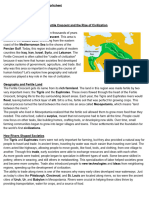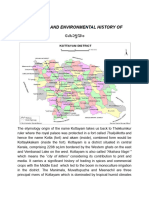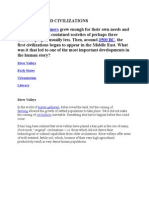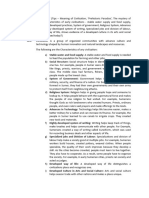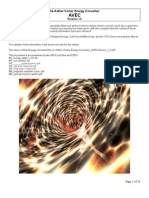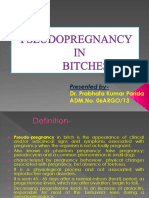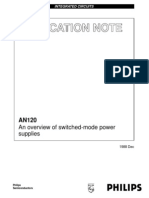100%(1)100% found this document useful (1 vote)
157 viewsADRAR
ADRAR
Uploaded by
BokretaAS I AM A FREELANCE WRITER AND A CULTURAL TOURISM CONSULTANT ,I PRESUME SENDING YOU SOME OF MY OWN ARTICLES AND REPORTS ON THE HISTORIC CITIES OF ALGERIA IN NORTH AFRICA.
SO GOOD RECEIPT AND GOOD VISION
TILL THEN
YOURS SINCERELY
Copyright:
Attribution Non-Commercial (BY-NC)
Available Formats
Download as PPS, PDF, TXT or read online from Scribd
ADRAR
ADRAR
Uploaded by
Bokreta100%(1)100% found this document useful (1 vote)
157 views14 pagesAS I AM A FREELANCE WRITER AND A CULTURAL TOURISM CONSULTANT ,I PRESUME SENDING YOU SOME OF MY OWN ARTICLES AND REPORTS ON THE HISTORIC CITIES OF ALGERIA IN NORTH AFRICA.
SO GOOD RECEIPT AND GOOD VISION
TILL THEN
YOURS SINCERELY
Copyright
© Attribution Non-Commercial (BY-NC)
Available Formats
PPS, PDF, TXT or read online from Scribd
Share this document
Did you find this document useful?
Is this content inappropriate?
AS I AM A FREELANCE WRITER AND A CULTURAL TOURISM CONSULTANT ,I PRESUME SENDING YOU SOME OF MY OWN ARTICLES AND REPORTS ON THE HISTORIC CITIES OF ALGERIA IN NORTH AFRICA.
SO GOOD RECEIPT AND GOOD VISION
TILL THEN
YOURS SINCERELY
Copyright:
Attribution Non-Commercial (BY-NC)
Available Formats
Download as PPS, PDF, TXT or read online from Scribd
Download as pps, pdf, or txt
100%(1)100% found this document useful (1 vote)
157 views14 pagesADRAR
ADRAR
Uploaded by
BokretaAS I AM A FREELANCE WRITER AND A CULTURAL TOURISM CONSULTANT ,I PRESUME SENDING YOU SOME OF MY OWN ARTICLES AND REPORTS ON THE HISTORIC CITIES OF ALGERIA IN NORTH AFRICA.
SO GOOD RECEIPT AND GOOD VISION
TILL THEN
YOURS SINCERELY
Copyright:
Attribution Non-Commercial (BY-NC)
Available Formats
Download as PPS, PDF, TXT or read online from Scribd
Download as pps, pdf, or txt
You are on page 1of 14
1.
Adrar- A view of a Palmeraie in the outskirts of Adrar
2.Adrar- A Beautiful architectural building in the town-centre
3.Adrar – A view of the Foggaras in the town centre
4.Adrar- A view of the Martyr’s place
5.Adrar- the main entrance to the City Bab Bechar
6.Adrar- a photo souvenir near the newly-built Sidi Belkebir’s Mosque
7.Adrar- A view at the outskirts of Adrar
8.Adrar- Another view of the Beautiful landscape
9.Adrar- A spiritual pause at Moulay Touhami’s Zawiya
IN THE NAME OF GOD THE COMPASSIONATE THE MERCIFUL
*Historic Cities of Algeria.
2. ADRAR.
Adrar is a province of south-western Algeria, named after its capital
Adrar A 1500 km distance south-west of Algiers the Capital, it is the
second-largest province, with an area of 427,368 km2, and the present
population is estimated at approximately 400.000 Inhabitants.
Adrar's historical name was given it by the local Berber people, the
Timmi, who established their ksar (fortified village) here, the modern
name is derived from the Berber adrar (mountain), the settlement lies
between the Erg (sand dunes) Chech and the Grand Erg Occidental
near the streambed of the Wadi Messaoud. The Adrar area was
historically a strategic point on the trade route between North and West
Africa.
It is bordered to the north by the Wilaya (province) of Bechar, El
Bayadh and Ghardaïa, to the west by the Wilaya of Tindouf, to the east
by the Wilaya of Tamanrasset, to the south by Mauritania and Mali.
Adrar is composed from three Regions: Touat (Adrar, Zaouit Kounta),
Gourara (Timimoun), and Tidikelt (Aoulef), divided into 11 Dairates
(counties), 28 Communes (towns) and 299 Ksars (fortified villages).
An unspeakable and incomparable beauty with oasis rosary and fields of sand roses and
a body of Ksours climbing back up very far in the time the whole ornamented by some
ancient historic monuments that erect themselves as majestic witnesses of a passed
cultural commercial and glorious Islamic civilization among these very well-known sites,
one notes the Region of Timimoun, Tamentit, and Aoulef. This intermingling gave birth to
a body of traditions and of cultural and hand-crafted practices that are still present today
in the life of its inhabitants translating into a wealth of the folklore and cultural heritage.
*ADRAR AND THE WATER CHANNELS OR FOGGARAS:
Adrar's main attraction must be the strange organisation of the town true that in the
middle lays a meaningless big square; it cannot be used to anything beyond parades
that hardly ever take place anyway. And out here in Sahara, big open squares are the
worst thing there is, nowhere to hide from the sun. There are easy to find traces of the
old system of underground water Channels. These traverse the entire oasis, and shall in
the times before modern systems were implemented, have been as long as 2,000 km in
this area alone.
Historically speaking, we may give a brief summary as to the erection of these
“Foggaras”, with the advent and the rapid expansion of Islam which genuinely provided
another major diffusion of the then technology of irrigation , spreading “Qanats” this
ingenious system of irrigation from Iran, went on to take another form and shape in
North Africa and its vast Sahara territory.
It is worth mentioning that the technology of Qanat has rapidly spread throughout
the Middle-East and North Africa under different names as for Touat region the
name “Foggara” was chosen for such irrigation system, a 600year old irrigation
system widely used in that area, this old-traditional human-made wetland of
channels and storage chambers built 10 to 15 meters (32'–48') below ground to
minimize evaporation, much like the qanats farther east.
Thanks to this system, farmers to this day grow more than 100 varieties of date
palms, 600,000 trees total across some 25,000 hectares (62,750 acres) of this
flourishing oasis, which also produces carrots, onions, fruits and other crops.
The “Foggaras” and the way of dividing water resources among different farmers
remain before all a collective commitment to such irrigation system in this area
and it stems from a deep Islamic culture largely sealed in the hearts of these
brave people as according to the Beloved Prophet Mohamed’s (PBUH) tradition
which stipulates that: “Muslims have common share in three things: pasture,
water and firewood” , moreover , it is crystal clear that in Muslim tradition, the
interests of the community take precedence over those of individuals or of small
groups, as is generally the case in much of the Western legislation.
So it is clear that in Adrar, Farmers rely on this ingenious and ancient system to capture
and distribute groundwater, the “foggaras” being a complex network of underground
channels and storage chambers that allow water to flow within the oases, the water is
then brought to the surface and distributed according to an ancestral social organization
via a tool called the “Kasria”.
The kasria is like a cookie cutter: a plate measuring some 25cm wide and 50cm long
with differently sized holes along its length. The kasria is inserted vertically into the
underground stream to bring water to the surface. This water is then divided into
channels of different sizes that run to individual gardens, whereas , the amount of water
is controlled by the size of the hole in the kasria, and corresponds to the need of
individual families as determined by a local committee.
In this way, the water is shared equitably for the cultivation of date palms as well as
cereals and
Vegetables and up to now, there is no objections whatsoever from all farmers of this
region to this
Water-distribution system which remains a legacy of many centuries and that is
rightly continuing but
misleading labels and slogans such as “agriculture-modernism” and “foreign
technical assistance”
according to some farmers are interfering with a new line of conduct which despite its
apparent “human
face” is certainly doomed to failure.
No wonder, that such wicked ill-fated attempt to harm and destabilise a
medieval and inspiring nostalgic
way of life is but a mere hatched plot to uproot all what is good and
proposing in return an inimical
and pernicious “prescription” in the form of the new tenets of
“Globalisation pills”.
And against all odds, Adrar is still consolidating its place as a spiritual
reputed learning centre before anything
with its three largest Schools or Zawiyyas respectively: the Sidi
Mohamed Belkebir Zawiyya, the Sheikh
Salem Ben Brahim Zawiyya and the Sheikh Moulay touhami in Ogadim
where more than 3000 Students are
learning and studying the Book of Allah is such a great contribution to the
spread of Islam and such ideals are
totally meant for the service of God and to Humanity at large in the path
of truth and knowledge seeking.
محمد بوكريطة الحسني
كاتب مستقل
mbokreta@maktoob.com
MOHAMED BOKRETA
Freelance-Writer
mohbokreta@yahoo.com
You might also like
- Thomas Moore - The Planets Within-Lindisfarne Books (1990) PDFDocument223 pagesThomas Moore - The Planets Within-Lindisfarne Books (1990) PDFIvana100% (26)
- 6th Central Pay Commission Salary CalculatorDocument15 pages6th Central Pay Commission Salary Calculatorrakhonde100% (436)
- Dr. Sebi Nutritional GuideDocument15 pagesDr. Sebi Nutritional GuideDonnaveo Sherman91% (54)
- Agricultural Innovation in The Early Islamic WorldDocument5 pagesAgricultural Innovation in The Early Islamic WorldRuben SanchezNo ratings yet
- Goa AbhishekAjwani PDFDocument28 pagesGoa AbhishekAjwani PDFAbhishekAjwaniNo ratings yet
- Islamic City PlanningDocument52 pagesIslamic City Planningqwerty100% (1)
- 60 Notes - 60 Years of ChallengeDocument4 pages60 Notes - 60 Years of ChallengeWladimir Esposito100% (2)
- Complete Download The Cloud DBA-Oracle: Managing Oracle Database in The Cloud 1st Edition Abhinivesh Jain PDF All ChaptersDocument25 pagesComplete Download The Cloud DBA-Oracle: Managing Oracle Database in The Cloud 1st Edition Abhinivesh Jain PDF All Chaptersaibanuekrema100% (3)
- Sustainable Irrigation Practices in Al AndalusDocument12 pagesSustainable Irrigation Practices in Al AndalusUmar SunusiNo ratings yet
- Ancient Wisdom To Face Challenging TimesDocument15 pagesAncient Wisdom To Face Challenging TimesElhabib Ahmed GhaliNo ratings yet
- متليلي انجليزيةDocument3 pagesمتليلي انجليزيةألعہأ قہلNo ratings yet
- Chashma Sugar MillsDocument31 pagesChashma Sugar Millssys.fast0% (1)
- Agricultural Milestones: From Ancient Practices to Modern MethodsFrom EverandAgricultural Milestones: From Ancient Practices to Modern MethodsNo ratings yet
- Taylor & Francis, Ltd. Bulletin (British Society For Middle Eastern Studies)Document4 pagesTaylor & Francis, Ltd. Bulletin (British Society For Middle Eastern Studies)Atef AlshehriNo ratings yet
- 1928 British SomalilandDocument10 pages1928 British SomalilandAbdirahman AbshirNo ratings yet
- Lesson 4 - The Fertile Crescent WorksheetDocument3 pagesLesson 4 - The Fertile Crescent WorksheetOmar ScafeNo ratings yet
- CihuatlánDocument11 pagesCihuatlánceeciliaotNo ratings yet
- Big Era 4 PresentationDocument45 pagesBig Era 4 PresentationGeorge LutonNo ratings yet
- Cultural and Environmental History of KottayamDocument16 pagesCultural and Environmental History of KottayamjesnaofficialNo ratings yet
- Development of Irrigation Systems EDITEDDocument11 pagesDevelopment of Irrigation Systems EDITEDEngr Altaf AwanNo ratings yet
- Chapter 4. Toward The Vision of Gardenworld - and An Image of A Viable FutureDocument20 pagesChapter 4. Toward The Vision of Gardenworld - and An Image of A Viable FutureDouglass CarmichaelNo ratings yet
- The Imaam Nanotwi Ceremony EreadDocument19 pagesThe Imaam Nanotwi Ceremony EreadtemaireNo ratings yet
- The Uses of River in Ancient Civilization - Penelusuran GoogleDocument1 pageThe Uses of River in Ancient Civilization - Penelusuran GoogleJacq RandNo ratings yet
- Bhis 111 World CivilizationsDocument45 pagesBhis 111 World CivilizationsPaul MachariaNo ratings yet
- History EssayDocument10 pagesHistory EssaysbanmuhammadstoreNo ratings yet
- Download ebooks file (Ebook) Plant ecology in the Middle East by Hegazy, Ahmad K.; Lovett Doust, Jon ISBN 9780199660810, 0199660816 all chaptersDocument71 pagesDownload ebooks file (Ebook) Plant ecology in the Middle East by Hegazy, Ahmad K.; Lovett Doust, Jon ISBN 9780199660810, 0199660816 all chapterszembaedger1lNo ratings yet
- The Plantationocene As Analytical Concept A Forum For Dialogue and ReflectionDocument24 pagesThe Plantationocene As Analytical Concept A Forum For Dialogue and ReflectionPeter RossetNo ratings yet
- Geography of The Middle EastDocument5 pagesGeography of The Middle EastacoonrodNo ratings yet
- Sheriff 1974Document9 pagesSheriff 1974Abdifatah MohamedNo ratings yet
- GHARDAIADocument17 pagesGHARDAIABokreta100% (5)
- Chapter 4. Toward The Vision of Gardenworld - and An Image of A Viable FutureDocument23 pagesChapter 4. Toward The Vision of Gardenworld - and An Image of A Viable FutureDouglass Carmichael100% (1)
- Haque - The Impact of Development of Kolkata On Tribal Culture of East Calcutta WetlandsDocument13 pagesHaque - The Impact of Development of Kolkata On Tribal Culture of East Calcutta WetlandsNadia ShalinNo ratings yet
- Soil and Water - A Source of Life - Need Sustainable Use For Sustainable CitiesDocument8 pagesSoil and Water - A Source of Life - Need Sustainable Use For Sustainable CitiesAmeer ZahidNo ratings yet
- FarhaanDocument7 pagesFarhaanLeya RoseNo ratings yet
- WHP-1200 Unit 2 FramesDocument3 pagesWHP-1200 Unit 2 Framesnm9207276No ratings yet
- Ebrahim_Nomadism, Settlement and DevelopmentDocument17 pagesEbrahim_Nomadism, Settlement and Developmentalsha1No ratings yet
- The Turkish Impact On The Changes of The Sudanese Socio-Cultural Life and DevelopmentDocument22 pagesThe Turkish Impact On The Changes of The Sudanese Socio-Cultural Life and Development10urtekerNo ratings yet
- Unseen And Untold: Captivating Facts About History, Culture, And LandmarksFrom EverandUnseen And Untold: Captivating Facts About History, Culture, And LandmarksNo ratings yet
- Ancient TimesDocument16 pagesAncient TimesRenalyn Ignacio DapiaoenNo ratings yet
- Ancient Times (Sts10 Report)Document41 pagesAncient Times (Sts10 Report)Errole Augusto MaxeyNo ratings yet
- Irrigation mesopotamiaDocument16 pagesIrrigation mesopotamiaDSJ GamesNo ratings yet
- Trip Tico InglesDocument2 pagesTrip Tico InglesrichideathNo ratings yet
- Irrigation Principles and Practices (IPP)Document306 pagesIrrigation Principles and Practices (IPP)Secret DuhhhNo ratings yet
- Ancient Afrika V1-2Document42 pagesAncient Afrika V1-2john_209_98625100% (1)
- Abdelaziz ADIDIDocument11 pagesAbdelaziz ADIDIZakaria OuzaidNo ratings yet
- (CHAO Et. Al. 2023) ThePlantationoceneAnalyticalConceptForumDialogueReflectionDocument25 pages(CHAO Et. Al. 2023) ThePlantationoceneAnalyticalConceptForumDialogueReflectionRafael CoutinhoNo ratings yet
- Cairo Clamorous Heart of EgyptDocument3 pagesCairo Clamorous Heart of Egyptlyndi beyers100% (1)
- GE6Chap1Document9 pagesGE6Chap1Althea Mikaella Dema-alaNo ratings yet
- Mohamed Bin Salam New Vision for the Land of Wonderful Skies Arabia Saudiof: Arabia Saudi, #1From EverandMohamed Bin Salam New Vision for the Land of Wonderful Skies Arabia Saudiof: Arabia Saudi, #1No ratings yet
- Chapter10 PDFDocument20 pagesChapter10 PDFjoenacchus brashNo ratings yet
- Biodiversity SolutionDocument2 pagesBiodiversity SolutionagcNo ratings yet
- Historical Antecedents 1Document17 pagesHistorical Antecedents 1Dnara PclbarNo ratings yet
- CHAPTER 1. Historial Antecedents of STSDocument61 pagesCHAPTER 1. Historial Antecedents of STSvalorang0444No ratings yet
- Hindu Today May 2013Document52 pagesHindu Today May 2013hudefNo ratings yet
- People of The Blue Mountains - BlavatskyDocument108 pagesPeople of The Blue Mountains - BlavatskyMark R. Jaqua100% (1)
- By The End of This Module, The Students Shall Be Able To:: Ancient TimesDocument14 pagesBy The End of This Module, The Students Shall Be Able To:: Ancient TimesJan Christian C. BarcelaNo ratings yet
- History ProjectDocument10 pagesHistory ProjectAnisha MukherjeeNo ratings yet
- TOWN PLANNING-convertedDocument6 pagesTOWN PLANNING-convertedHurmat WaheedNo ratings yet
- Planning Efforts and Impacts On Historical Cities: "Mesopotamia"Document6 pagesPlanning Efforts and Impacts On Historical Cities: "Mesopotamia"Shivaraju HNo ratings yet
- Irrigation SystemDocument9 pagesIrrigation SystemDILRUKSHINo ratings yet
- (ĐLNV) Chap 7Document13 pages(ĐLNV) Chap 7Minh Anh NguyenNo ratings yet
- Sharjah Heritage and ProgressDocument11 pagesSharjah Heritage and ProgressbooksarabiaNo ratings yet
- Civilizations - MesopotamiaDocument7 pagesCivilizations - Mesopotamialavanya.pervelaNo ratings yet
- The Royal MausoleumDocument8 pagesThe Royal MausoleumBokreta100% (1)
- Sidi Al IllouliDocument9 pagesSidi Al IllouliBokreta50% (2)
- Sidi Braham Al GhobriniDocument7 pagesSidi Braham Al GhobriniBokreta50% (2)
- TIMIMOUNDocument12 pagesTIMIMOUNBokretaNo ratings yet
- Sidi Ahmed TijaniDocument15 pagesSidi Ahmed TijaniBokreta100% (16)
- Sidi Ahmed BenyoucefDocument11 pagesSidi Ahmed BenyoucefBokreta100% (3)
- The Kourdane PalaceDocument12 pagesThe Kourdane PalaceBokretaNo ratings yet
- GaryHalbertDeceptionAd 2 PDFDocument1 pageGaryHalbertDeceptionAd 2 PDFkaran vaghela100% (1)
- Data Types in Java: Dr. Kumud TripathiDocument12 pagesData Types in Java: Dr. Kumud TripathiSIDHANT BHAGATNo ratings yet
- ISBN Fatigue Prevention in The Workplace Guide 2017 06 - 2Document26 pagesISBN Fatigue Prevention in The Workplace Guide 2017 06 - 2Muhammad Alhy HusyainNo ratings yet
- Aether Vortex Energy Converter - AVEC Device - 1 - 0Document34 pagesAether Vortex Energy Converter - AVEC Device - 1 - 0rj_duffy100% (2)
- English Grammar 101Document8 pagesEnglish Grammar 101Chris Hogan100% (1)
- Examen Pentru Verificarea Cunostintelor de Limba Engleza Pentru Admiterea in Clasa A IxDocument3 pagesExamen Pentru Verificarea Cunostintelor de Limba Engleza Pentru Admiterea in Clasa A Ixemutza79No ratings yet
- Ingredients of Yangzey RilbuDocument2 pagesIngredients of Yangzey Rilbuzyx911023No ratings yet
- Gujarat Technological UniversityDocument1 pageGujarat Technological UniversityPrarthana DubeyNo ratings yet
- University of Kerala: Prospectus For Admission To The B.Ed. DEGREE COURSE 2018-20 (Two Year Programme)Document26 pagesUniversity of Kerala: Prospectus For Admission To The B.Ed. DEGREE COURSE 2018-20 (Two Year Programme)kalkkippNo ratings yet
- Presented By-: Dr. Prabhata Kumar Parida ADM - No. 06ARGO/13Document19 pagesPresented By-: Dr. Prabhata Kumar Parida ADM - No. 06ARGO/13Krushna krupa PradhanNo ratings yet
- ENG 3A Purposive Communication Final Term ModuleDocument119 pagesENG 3A Purposive Communication Final Term ModuleVince Andrei MayoNo ratings yet
- 51 Din 51 Marathon by Prashant Sir Day 01 Subject Verb AgreementDocument2 pages51 Din 51 Marathon by Prashant Sir Day 01 Subject Verb AgreementChandan Sekhar sahuNo ratings yet
- Booij Et Al-1999-Journal of Geophysical Research: Oceans (1978-2012)Document18 pagesBooij Et Al-1999-Journal of Geophysical Research: Oceans (1978-2012)Aldemar Elías Higgins AlvarezNo ratings yet
- CBR English Kelompok 9Document4 pagesCBR English Kelompok 9Devi TariganNo ratings yet
- An Overview of Switched-Mode Power Supplies: Integrated CircuitsDocument6 pagesAn Overview of Switched-Mode Power Supplies: Integrated CircuitsJohn Wanyoike MakauNo ratings yet
- PDF The Handbook of Communication Skills 4th Edition Owen Hargie DownloadDocument67 pagesPDF The Handbook of Communication Skills 4th Edition Owen Hargie Downloadpertzholer100% (2)
- Ch4. Three-Hinged Arches, ManualDocument8 pagesCh4. Three-Hinged Arches, ManualJose David Rodrigues CotrinaNo ratings yet
- Preparing A Business SpeechDocument15 pagesPreparing A Business Speechgrace manikNo ratings yet
- AL-ATTAS, S. M. (1970) The Mysticism of Hamzah FansuriDocument3 pagesAL-ATTAS, S. M. (1970) The Mysticism of Hamzah FansuriRifqi IkhwanuddinNo ratings yet
- Toefl Practice Listening Overview - 023019Document2 pagesToefl Practice Listening Overview - 023019Chintia ArifaNo ratings yet
- Findings of IBM WATSON Procedural Way To Play Jeopardy Game ShowDocument5 pagesFindings of IBM WATSON Procedural Way To Play Jeopardy Game ShowijcnesNo ratings yet
- Ago vs. CADocument3 pagesAgo vs. CAJan Carlo SanchezNo ratings yet
- Electric Current, Resistance and ResistivityDocument8 pagesElectric Current, Resistance and ResistivityPavan BoroNo ratings yet
- Sikh Community Profile Infographic English AFDocument4 pagesSikh Community Profile Infographic English AFPritpalNo ratings yet
- LibmanDocument8 pagesLibmanManjeev GuragainNo ratings yet
- Emirates Airline SWOT by AbdullahDocument3 pagesEmirates Airline SWOT by AbdullahAbdullah Sulaiman Aloraini100% (3)
- Urim and ThummimDocument27 pagesUrim and ThummimCarla MissionaNo ratings yet















